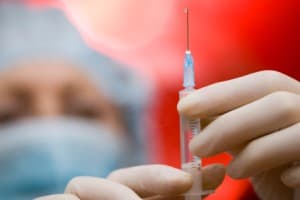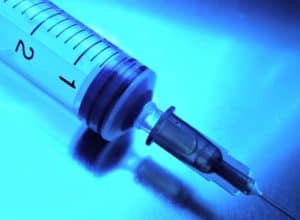Effect of intravenous fluid choice on patient outcomes in the ED

Normal saline solution and lactated Ringer’s solution were associated with similar 24-hour recovery scores and 7-day health care use in stable ED patients. These results supplement those of recent trials by informing fluid choice for stable ED patients” Friederich et al (2018). Abstract: Study objective: The purpose of this study is to test the hypothesis […]
Diagnosis of air embolism from a central venous catheter

Here, we report a case of CAE associated with a central venous catheter in the internal jugular vein that resulted in neurological deficits and generalised epileptic seizures” Khaliq et al (2018). Abstract: Cerebral air embolism (CAE) is a rare, avoidable and potentially fatal iatrogenic complication. Here, we report a case of CAE associated with a […]
Geriatric hemodialysis patient survival factors described

The present study revealed that comorbidities and low performance status at the onset of dialysis had shortened the survival time in the geriatric hemodialysis patient group” Tuğcu et al (2018). Abstract: INTRODUCTION: The number of geriatric patients is increasing in hemodialysis population over the years and mortality is higher in this group of patients. This […]
Premixed IV antimicrobials reduced time to administration of the first dose in sepsis

The objective of this study was to evaluate the impact of antimicrobial preparation on time to administration in septic patients located in the emergency department (ED)” Kufel et al (2018). Abstract: OBJECTIVE: Strategies that reduce the time to antimicrobial administration, such as the availability of premix antimicrobials (PMAs) in the emergency department (ED), may better […]
Vancomycin levels tested from a central venous catheter

Carryover from prior infusions does not appear to jeopardize measurements of piperacillin-tazobactam, meropenem, or vancomycin in commonly used vascular catheters at our institution” Marsh et al (2018). Abstract: BACKGROUND: Therapeutic drug monitoring is used for aminoglycosides and vancomycin, and has been proposed for β-lactam antibiotics. Clinical blood samples in the ICU are often obtained via […]
Mediastinal haematoma following central venous catheter insertion

Mediastinal haematoma is a rare complication of CVC insertion. It is most commonly due to perforation of the subclavian vein by the guidewire or dilator” Ali et al (2017). Extract: Mediastinal haematoma is a rare complication of CVC insertion. It is most commonly due to perforation of the subclavian vein by the guidewire or dilator. […]
Clostridium difficile infection prevention during CVC antibiotic administration

We hypothesised that daily oral administration of the anion-binding resin colestyramine (cholestyramine) would help prevent infections in those receiving intravenous antibiotic treatment via CVADs” Puri et al (2018). Abstract: Background: The use of indwelling central venous access devices (CVADs) is associated with the development of bloodstream infections. When CVADs are used to administer systemic antibiotics, […]
Review of pediatric central venous catheter complications

The aim of this study was to evaluate CVC and catheter related complications in our tertiary pediatric intensive care unit” Tolunay et al (2018). Abstract: In catheter-using units as pediatric intensive care, it is important to know the complications that may occur during the insertion and use of central venous catheterization (CVC), and to take […]
Adoption of SecurAcath for PICC securement within the National Health Service in England

SecurAcath is a catheter securement device designed for central venous catheters. The National Institute for Health and Care Excellence, as a part of its Medical Technologies Evaluation Programme, selected this device for evaluation and invited the manufacturer, Interrad Medical, to submit clinical and economic evidence” Macmillan et al (2018). Abstract: Central venous catheters are commonly […]
CLABSI reduction with daily bathing using chlorhexidine gluconate cloths

Evidence supports daily bathing using chlorhexidine gluconate (CHG) cloths to decrease preventable hospital-acquired central line-associated bloodstream infections (CLABSIs)” Reynolds et al (2018). Abstract: BACKGROUND: Evidence supports daily bathing using chlorhexidine gluconate (CHG) cloths to decrease preventable hospital-acquired central line-associated bloodstream infections (CLABSIs). However, implementation of this practice is inconsistent. Using multifaceted strategies to promote implementation […]
Chronic intestinal failure cost analysis shows decline after first year

HPN related costs accounted for the majority of the total expenses in IF patients. The costs declined after the first year due to a reduction in complications and hospital admissions” Canovaiet al (2018). Abstract: BACKGROUND & AIMS: Chronic intestinal failure is a complex medical condition which is associated with high costs. These patients require long-term […]
Home parenteral nutrition patients participate in an international study on quality of life

The aims of this study were: to re-assess the basic psychometric properties of the HPN-QOL© in a multinational sample of adult patients; to provide a description of QOL dimensions by short and long HPN treatment duration; to explore clinical factors potentially associated to QOL scores” Baxter et al (2018). Abstract: BACKGROUND & AIMS: Home parenteral […]
Thromboembolism incidence and risk factors in children with cancer

Objectives were to describe the incidence and risk factors of TE in children with cancer” Pelland-Marcotte et al (2018). Abstract: There is conflicting information about the epidemiology of thromboembolism (TE) in paediatric oncology. Objectives were to describe the incidence and risk factors of TE in children with cancer. We included all children with cancer less […]
Patient experience with vascular access during treatment for early-stage breast cancer

Most patients reported being satisfied with the vascular access used for their treatment. Improved education and understanding about the evidence-based requirements for vascular access are needed” LeVasseur et al (2018). Abstract BACKGROUND: The choice of vascular access for systemic therapy administration in breast cancer remains an area of clinical equipoise, and patient preference is not […]
Optimizing vascular access for early-stage breast cancer patients

Despite widespread use of chemotherapy for patients with breast cancer, the type of venous access used for treatment varies significantly, as do perceptions about the risks of cvad use and the risk for lymphedema development” LeVasseur et al (2018). Abstract: BACKGROUND: Despite advances in systemic therapy choices for patients with early-stage breast cancer, optimal practices […]
Phlebitis assessment associated with peripheral vein cannulation

Duration of venous cannulation median indicated that most of the catheters were removed on the second day. When veins inflammation was diagnosed, the most frequent action was to remove the catheter” Cimała et al (2018). Abstract: INTRODUCTION: Peripheral veins cannulation is one of the most frequently executed medical procedures. Primary blood infections which might be […]
Impact of home parenteral nutrition on improving quality of life

To assess the effectiveness of home parenteral nutrition (HPN) in improving survival and quality of life in people with inoperable MBO” Sowerbutts et al (2018). Abstract: BACKGROUND: People with advanced ovarian or gastrointestinal cancer may develop malignant bowel obstruction (MBO). They are able to tolerate limited, if any, oral or enteral (via a tube directly […]
Treatment options for extravasation of liposomal and pegylated liposomal anthracyclines

The aim of this paper was to review the scientific literature on the extravasation of liposomal and pegylated liposomal anthracyclines and determine the clinical impact of this type of extravasation, focusing on dexrazoxane” Caballero Romero et al (2018). Abstract: The extravasation of chemotherapeutic agents is a challenge for oncologic care teams. The management of nonliposomal […]
Recommended implantable port flush volume identified

This study investigates the best irrigation volume for an intravenous port by simulating the clinical scenario ex-vivo to access its usefulness” Wu et al (2018). Abstract: BACKGROUND: An intravenous port, which differs from a central venous catheter, has an injection chamber at the end of the catheter. This structural difference causes the irrigation flow pattern […]
Peripheral intravenous catheter first time insertion rates

Peripheral intravenous catheter insertion is a clinical procedure commonly performed by nurses for pediatric patients in Bhutan. This study describes peripheral intravenous catheter first attempt success and factors associated with such insertions” Choden et al (2018). Abstract: INTRODUCTION: Peripheral intravenous catheter insertion is a clinical procedure commonly performed by nurses for pediatric patients in Bhutan. […]
Vascular access device placement in elderly hemodialysis patients

Among incident hemodialysis patients ≥80 years of age, placement of an AVF from a CVC within the first year of dialysis had similar mortality compared with initial AVF use. Our data suggest that initial CVC use with later placement of an AVF may be an acceptable option among elderly hemodialysis patients” Ko et al(2018). Abstract: BACKGROUND: […]
Intraosseous access device comparison of efficacy

As an alternative, medications and fluids can be administered via the intraosseous (IO) route, which is a well-tolerated and established alternative, especially in the emergency setting” Szarpak et al (2018). Abstract: BACKGROUND: Obtaining intravascular access can be challenging or even impossible in several clinical situations. As an alternative, medications and fluids can be administered via […]
Umbilical catheter-related complications identified with ultrasound

This pictorial review illustrates the sonographic findings of complications that should be excluded in the sick neonate with an indwelling catheter” Selvam et al (2018). Abstract: Umbilical catheters are commonly used in the neonatal period for blood sampling or for administering medication or parenteral nutrition. The position of the catheter is usually confirmed with radiography. […]
Introduction of peripheral IV cannula care programme

A Quality Improvement Programme was initiated that centred on hand hygiene (HH) compliance before and after patient contact, and the introduction of peripheral cannula care and surveillance” Bowley et al (2018). Abstract: INTRODUCTION: The WHO Constitution enshrines ‘…the highest attainable standard of health as a fundamental right of every human being.’ Strengthening delivery of health […]
Subcutaneous administration of biotherapeutics overview

Subcutaneous delivery of biotherapeutics has become a valuable alternative to intravenous administration across many disease areas” Bittner et al (2018). Abstract: Subcutaneous delivery of biotherapeutics has become a valuable alternative to intravenous administration across many disease areas. Although the pharmacokinetic profiles of subcutaneous and intravenous formulations differ, subcutaneous administration has proven effective, safe, well-tolerated, generally […]
Evaluation of a hospital-wide infection control programme

To evaluate whether a hospital-wide infection control programme (ICP) is effective at reducing the burden of healthcare-associated infections (HAIs) and associated severe sepsis/septic shock or death (severe HAIs)” Hagel et al (2018). Abstract: Objectives: To evaluate whether a hospital-wide infection control programme (ICP) is effective at reducing the burden of healthcare-associated infections (HAIs) and associated […]
Aggressive fluid therapy for pain control in pediatric acute pancreatitis

However, most of these interventions are tailored for adult patients and there is a paucity of information regarding the optimal analgesic intervention for pediatric patients suffering from AP in the emergency department” Assadi (2018). Abstract: It has been estimated that the incidence of emergency department visits due to acute pancreatitis (AP) in children is roughly […]
Assisted tunneled cuffed central catheter placement

We developed a new device to support accurate placement of the tunneled cuffed catheter. In this study, we report our first clinical experience of the device” Ohara et al (2018). Abstract: Introduction: The tunneled cuffed catheter is used in hemodialysis patients for whom an arteriovenous fistula or arteriovenous graft is not suitable or for bridging […]
ECG PICC tip location accuracy and safety reviewed

This study was aimed to evaluate the accuracy and safety of bedside electrocardiograph (ECG)-guided tip location technique in PICC in cancer patients, and compared with traditional chest radiography tip location technique” Li et al (2018). Abstract: BACKGROUND & OBJECTIVES: The peripherally inserted central catheter (PICC) has the advantages of higher safety, lower infection rate and […]
Central line infection prevention focusing on removal of unnecessary central lines

We demonstrated that a workable MIPT initiative focusing on removal of unnecessary CL and UC can be easily implemented in an LTACH requiring minimal time and resources. A rebound increase in UC-DURs to pre-intervention levels after intervention end indicates that continued vigilance is required to maintain performance” Chandramohan et al (2018). Abstract: BACKGROUND: Prolonged central […]

